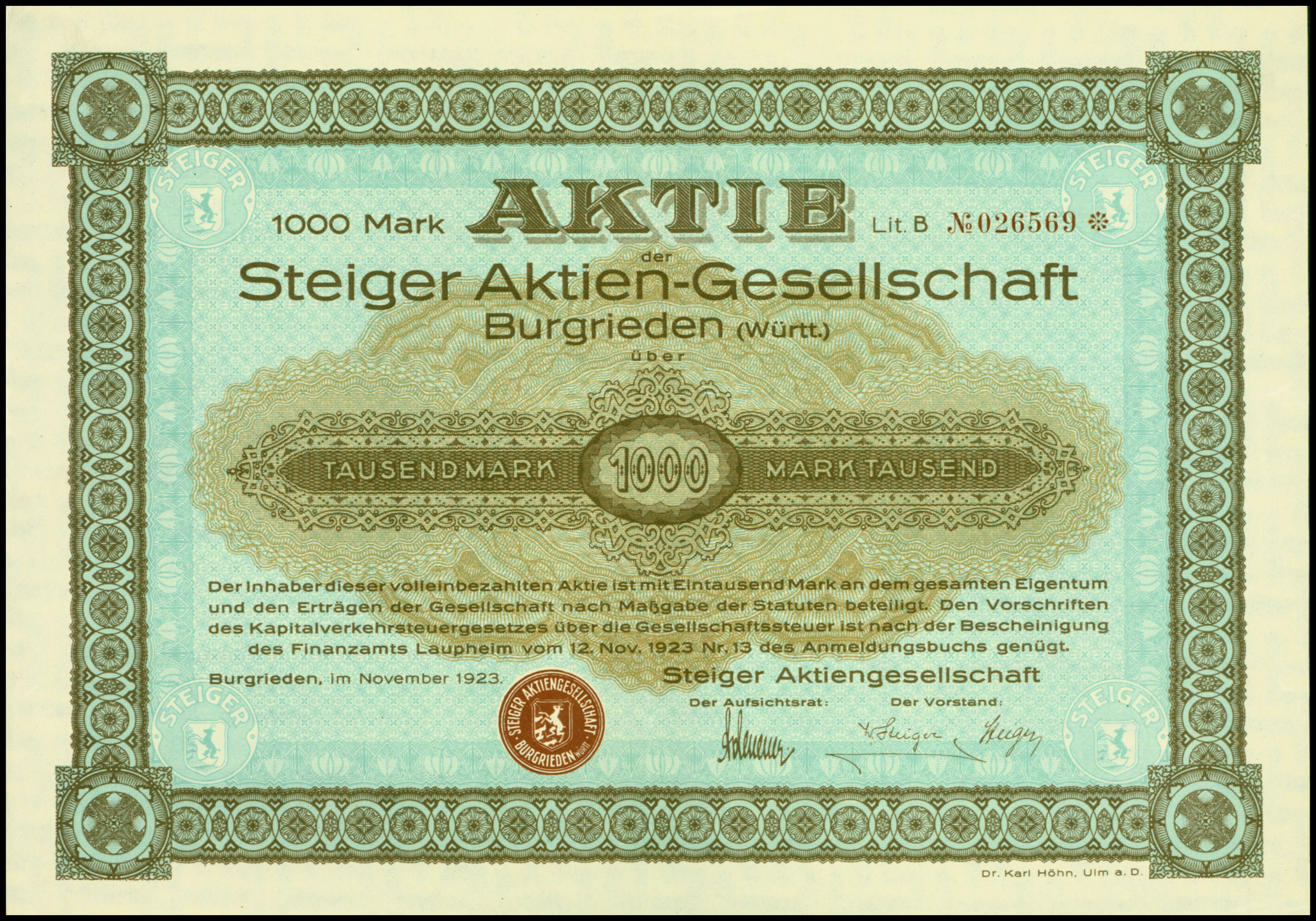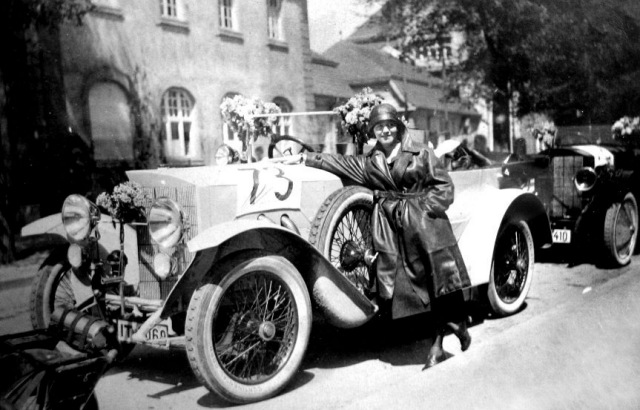Steiger (automobile Company) on:
[Wikipedia]
[Google]
[Amazon]
 The Steiger company was founded in 1914 as Maschinenfabrik (engine manufactory) Walther Steiger & Co. by the Swiss engineer Walther Steiger (1881–1943) in
The Steiger company was founded in 1914 as Maschinenfabrik (engine manufactory) Walther Steiger & Co. by the Swiss engineer Walther Steiger (1881–1943) in 
 During
During
 In 1922 Steiger produced a two-seated roadster with a larger engine (cubic capacity 2.8 litres, 55 hp / 40 kW) that became available in 1924 as an even more powerful model (cubic capacity 2.9 litres, 70 hp / 51 kW). These types reached a maximum speed of 140 km/h (88 mph) (100 hp racing models could reach a speed of 180 km/h (113 mph)) and cost 18,000
In 1922 Steiger produced a two-seated roadster with a larger engine (cubic capacity 2.8 litres, 55 hp / 40 kW) that became available in 1924 as an even more powerful model (cubic capacity 2.9 litres, 70 hp / 51 kW). These types reached a maximum speed of 140 km/h (88 mph) (100 hp racing models could reach a speed of 180 km/h (113 mph)) and cost 18,000
 After the liquidation of his firm, Walther Steiger joined the Swiss automobile manufacturer
After the liquidation of his firm, Walther Steiger joined the Swiss automobile manufacturer

Image:Steiger_automobile_10.jpg, The last one: Steiger 11/55 PS
Image:Steiger_automobile_11.jpg , Steiger engineer Walter Kaufmann on Steiger racing car, type Targa-Florio (1924)
Image:Steiger_automobile_16.jpg , Eye catcher – Steiger 10/50 PS
Steiger-burgrieden
��{{in lang, de
Vintage vehicles Defunct motor vehicle manufacturers of Germany Vehicle manufacturing companies established in 1914 Vehicle manufacturing companies disestablished in 1926 1926 disestablishments in Germany German companies established in 1914
 The Steiger company was founded in 1914 as Maschinenfabrik (engine manufactory) Walther Steiger & Co. by the Swiss engineer Walther Steiger (1881–1943) in
The Steiger company was founded in 1914 as Maschinenfabrik (engine manufactory) Walther Steiger & Co. by the Swiss engineer Walther Steiger (1881–1943) in Burgrieden
Burgrieden () is a municipality in the district of Biberach in Baden-Württemberg, in Germany
Germany, officially the Federal Republic of Germany, is a country in Central Europe. It lies between the Baltic Sea and the North Sea to the n ...
near Ulm
Ulm () is the sixth-largest city of the southwestern German state of Baden-Württemberg, and with around 129,000 inhabitants, it is Germany's 60th-largest city.
Ulm is located on the eastern edges of the Swabian Jura mountain range, on the up ...
, Germany. In 1921 it became a limited company
In a limited company, the Legal liability, liability of members or subscribers of the company is limited to what they have invested or guaranteed to the company. Limited companies may be limited by Share (finance), shares or by guarantee. In a c ...
(Steiger AG). During its short life the firm produced circa 1,200 vehicles.

Founding and Early History
World War I
World War I or the First World War (28 July 1914 – 11 November 1918), also known as the Great War, was a World war, global conflict between two coalitions: the Allies of World War I, Allies (or Entente) and the Central Powers. Fighting to ...
the Steiger firm repaired aeroplanes
An airplane (American English), or aeroplane (Commonwealth English), informally plane, is a fixed-wing aircraft that is propelled forward by thrust from a jet engine, propeller, or rocket engine. Airplanes come in a variety of sizes, shapes, ...
and aeroplane engines. In 1917 the owner and his engineer, Paul Henze, began to work on motorized vehicles. Plans for the manufacture of tractors were abandoned in favour of automobiles; their first model, the Steiger 10/50 PS, was produced in 1920. This touring model with a 2.6-litre four cylinder engine (50 hp / 37 kW) became Steiger's most significant product and was still in production when the firm collapsed in 1926. Its modern OHC
An overhead camshaft (OHC) engine is a piston engine in which the camshaft is located in the cylinder head above the combustion chamber. This contrasts with earlier overhead valve engines (OHV), where the camshaft is located below the combustio ...
engine was distinctive because of an overhead camshaft
A camshaft is a shaft that contains a row of pointed cams in order to convert rotational motion to reciprocating motion. Camshafts are used in piston engines (to operate the intake and exhaust valves), mechanically controlled ignition syst ...
driven by spiral-toothed bevel gear wheels. These cars, with 'u' shaped pressed steel frames, two axles with leaf spring suspension, and a pointed radiator, were considered to be "the most significant technical innovation of the early 1920s" and "the most progressive German serially-produced cars of their time".
A brief flowering
 In 1922 Steiger produced a two-seated roadster with a larger engine (cubic capacity 2.8 litres, 55 hp / 40 kW) that became available in 1924 as an even more powerful model (cubic capacity 2.9 litres, 70 hp / 51 kW). These types reached a maximum speed of 140 km/h (88 mph) (100 hp racing models could reach a speed of 180 km/h (113 mph)) and cost 18,000
In 1922 Steiger produced a two-seated roadster with a larger engine (cubic capacity 2.8 litres, 55 hp / 40 kW) that became available in 1924 as an even more powerful model (cubic capacity 2.9 litres, 70 hp / 51 kW). These types reached a maximum speed of 140 km/h (88 mph) (100 hp racing models could reach a speed of 180 km/h (113 mph)) and cost 18,000 Reichsmarks
The (; Currency sign, sign: ℛ︁ℳ︁; abbreviation: RM) was the currency of German Reich, Germany from 1924 until the fall of Nazi Germany in 1945, and in the Bizone, American, British and French occupied zones of Germany, until 20 June 19 ...
. Those high-performance sports and racing models were very successful at racing events (Solituderennen
The ''Solituderennen'' (eng: ''Solitude race'') motorsport events are held on the 11.4 km ''Solitude_Racetrack, Solitudering'' race track near Stuttgart. The event and the track were named after the nearby Castle Solitude#Race track, Castle S ...
, Avus
The ('Automobile traffic and training road'), known as AVUS (), is a public road in Berlin, Germany. Opened in 1921, it was also used as a motor racing circuit until 1998. Today, the AVUS forms the northern part of the Bundesautobahn 115.
C ...
, Eifelrennen
The Eifelrennen was an annual motor race, organised by ADAC Automobile Club from 1922 to 2003, held in Germany's Eifel mountain region.
Like other races of its time it was first held on public roads. In 1927 it was moved to the newly-built Nürbu ...
, Klausenrennen, Monza
Monza (, ; ; , locally ; ) is a city and ''comune'' (municipality) on the Lambro, River Lambro, a tributary of the Po (river), River Po, in the Lombardy region of Italy, about north-northeast of Milan. It is the capital of the province of Mo ...
and Targa Florio
The Targa Florio was a public road Endurance racing (motorsport), endurance automobile race held in the mountains of Sicily near the island's capital of Palermo, Sicily, Palermo. Founded in 1906 Targa Florio, 1906, it was the oldest sports car ra ...
) in the 1920s. The more powerful touring car, the Steiger 11/55 PS, arrived in 1925 with an extended wheelbase
In both road and rail vehicles, the wheelbase is the horizontal distance between the centers of the front and rear wheels. For road vehicles with more than two axles (e.g. some trucks), the wheelbase is the distance between the steering (front ...
and the first sports car's engine.
In the early 1920s, the Steiger company even had a sales office in the USA. The address in Manhattan
Manhattan ( ) is the most densely populated and geographically smallest of the Boroughs of New York City, five boroughs of New York City. Coextensive with New York County, Manhattan is the County statistics of the United States#Smallest, larg ...
: "Steiger Motor Car Co., Inc." - 134 W 52nd St, New York City
New York, often called New York City (NYC), is the most populous city in the United States, located at the southern tip of New York State on one of the world's largest natural harbors. The city comprises five boroughs, each coextensive w ...
.
At its peak the firm occupied up to 500 workers and employees. Despite their high-class products that were often compared with those of Bugatti
Automobiles Ettore Bugatti was a German then French automotive industry, manufacturer of high performance vehicle, high-performance automobiles. The company was founded in 1909 in the then-German Empire, German city of Molsheim, Alsace, by the ...
, the firm went bankrupt in the wake of the 1926 automobile crisis.
Steiger-Martini
 After the liquidation of his firm, Walther Steiger joined the Swiss automobile manufacturer
After the liquidation of his firm, Walther Steiger joined the Swiss automobile manufacturer Martini
Martini may refer to:
* Martini (cocktail), a drink made with gin and vermouth, garnished with an olive or a lemon twist
* Martini (vermouth), a brand of vermouth
* Martini (surname), an Italian surname
* Martini (automobile company), a Swiss auto ...
where he and his brother Robert had been the major shareholders since 1924. They produced a number of vehicles for Martini, including a 95 hp (70 kW) six-cylinder model. This luxury vehicle with a 4.4-litre engine appeared in Switzerland as Martini-Six and in Germany as 17/100 PS Steiger-Martini.Jung, pp. 86 ff.
Following the pattern at Steiger, a number of different racing models were developed, and some achieved spectacular successes (twice reaching the first four in the 1929 Klausenpass race, for example). However, these carefully and individually manufactured models could not compete in the long run with cheaper, mass-produced vehicles from Germany, France and America. The end of a brand steeped in tradition was inevitable: on 12 June 1934 the last Martini left the factory in Saint-Blaise on Lake Neuchâtel
Lake Neuchâtel ( ; ; ) is a lake primarily in Romandy, the French-speaking part of Switzerland. The lake lies mainly in the canton of Neuchâtel, but is also shared by the cantons of Vaud, Fribourg, and Bern. It comprises one of the lakes in th ...
.
Steiger models

See also
*Martini (automobile company)
Martini was a pioneer Switzerland, Swiss automobile manufacturer, in operation 1897 to 1934.
History The beginning
In 1897, Swiss businessman Adolf von Martini, son of Friedrich von Martini, the inventor of the action used in the Martini– ...
– Saint-Blaise, Switzerland
* auto motor und sport-TV: "Die faszinierendsten Autos der Welt – Klassiker", DVD (2002), EAN 4-260000-950484, Youtube: yy-3BHWqXkI
* ARD "Rasthaus" 1999 (German TV) "Der fast vergessene Steiger", Youtube: 4dEkE5hlXek
Pictures
Sources
* Hans-Heinrich v. Fersen (1): ''Autos in Deutschland 1920–1939''. Stuttgart 1964. * Hans-Heinrich v. Fersen, a.o. (2): ''Klassische Wagen 1919–1939''. Cologne 1994, * Ferdinand Hediger: ''Oldtimer – Interessante Automobile von 1885–1939''. Berne 1982, * Helmut and Uta Jung: ''Stuttgarter Karosseriewerk Reutter''. Bielefeld 2006, * Ralf J.F. Kieselbach and Hans-Erhard Lessing: ''Faszination der Form – Automobildesign in Baden-Württemberg''. Stuttgart, Weimar 2002, * Werner Oswald: ''Deutsche Autos 1920–1945''. Stuttgart 1982, * Michael Schick: ''Steiger – Die Geschichte einer schwäbischen Autofabrik in den 20er Jahren''. Laupheim 1999,References
External links
Steiger-burgrieden
��{{in lang, de
Vintage vehicles Defunct motor vehicle manufacturers of Germany Vehicle manufacturing companies established in 1914 Vehicle manufacturing companies disestablished in 1926 1926 disestablishments in Germany German companies established in 1914